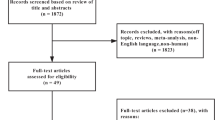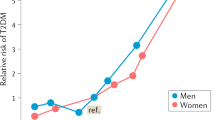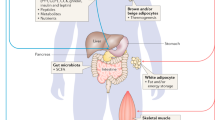Abstract
At the beginning of the last century obesity and type 2 diabetes were treated quite successfully using low-carbohydrate diets. Following the discovery of insulin, the carbohydrate content of the diabetic diet became more liberal, as glycaemia and glycosuria could be controlled, more or less well, with hypoglycaemic medication and insulin treatment. Later, saturated fats and high-plasma cholesterol concentrations were implicated in cardiovascular disease and since then high-carbohydrate diets have become synonymous with ‘health’ and have been conventional nutrition doctrine for the past 40 years. In spite of this, the prevalence of some non-communicable metabolic diseases have increased to epidemic proportions and have led an increasing number of researchers in the fields of medicine and nutrition to challenge the validity of present-day dietary guidelines. There is increasing evidence that diets with a lower, or even very-low, carbohydrate content can help overweight and obese individuals to lose and maintain lost weight, diabetics to control blood glucose with more ease and prevent the development of diabetic complications, while at the same time improving blood lipid profiles and biomarkers of cardiovascular risk. The present review considers the evolution of our diet and questions whether high-carbohydrate diets are indeed synonymous with health.
This is a preview of subscription content, access via your institution
Access options
Subscribe to this journal
Receive 12 print issues and online access
$259.00 per year
only $21.58 per issue
Buy this article
- Purchase on Springer Link
- Instant access to full article PDF
Prices may be subject to local taxes which are calculated during checkout


Similar content being viewed by others
References
Thomas Robert Malthus http://en.wikipedia.org/wiki/Thomas_Robert_Malthus (accessed on 31 January 2012).
Milton K . The critical role played by animal source foods in human (Homo) evolution. J Nutr 2003; 133 (Suppl 2), 3886S–3892S.
Cordain L, Eaton SB, Miller JB, Mann N, Hill K . The paradoxical nature of hunter-gatherer diets: meat-based, yet non-atherogenic. Eur J Clin Nutr 2002; 56 (Suppl 1), S42–S52.
Strohle A, Hahn A . Diets of modern hunter-gatherers vary substantially in their carbohydrate content depending on ecoenvironments: results from an ethnographic analysis. Nutr Res 2011; 31: 429–435.
Eaton SB . The ancestral human diet: what was it and should it be a paradigm for contemporary nutrition? Proc Nutr Soc 2006; 65: 1–6.
Garn SM, Leonard WR . What did our ancestors eat? Nutr Rev 1989; 47: 337–345.
Konner M, Eaton SB . Paleolithic nutrition: twenty-five years later. Nutr Clin Pract 2010; 25: 594–602.
Stephen AM, Wald NJ . Trends in individual consumption of dietary fat in the United States, 1920-1984. Am J Clin Nutr 1990; 52: 457–469.
Keys A . Atherosclerosis: a problem in newer public health. J Mt Sinai Hosp N Y 1953; 20: 118–139.
Yerushalmy J, Hilleboe HE . Fat in the diet and mortality from heart disease; a methodologic note. N Y State J Med 1957; 57: 2343–2354.
Keys A . Prediction and possible prevention of coronary disease. Am J Public Health Nations Health 1953; 43: 1399–1407.
Kritchevsky D . History of recommendations to the public about dietary fat. J Nutr 1998; 128 (Suppl 2), 449S–452S.
Report of Inter-Society Commission for Heart Disease Resources. Prevention of cardiovascular disease. Primary prevention of the atherosclerotic diseases. Circulation 1970; 42: A55–A95.
Stamler J . Diet and coronary heart disease. Biometrics 1982; 38 (Suppl), 95–118.
Gidding SS, Lichtenstein AH, Faith MS, Karpyn A, Mennella JA, Popkin B et al. Implementing American Heart Association pediatric and adult nutrition guidelines: a scientific statement from the American Heart Association Nutrition Committee of the Council on Nutrition, Physical Activity and Metabolism, Council on Cardiovascular Disease in the Young, Council on Arteriosclerosis, Thrombosis and Vascular Biology, Council on Cardiovascular Nursing, Council on Epidemiology and Prevention, and Council for High Blood Pressure Research. Circulation 2009; 119: 1161–1175.
US Department of Agriculture, US Department of Health and Human Services Report of the Dietary Guidelines Advisory Committee on the dietary guidelines for Americans, 2010.
Kushi LH, Byers T, Doyle C, Bandera EV, McCullough M, McTiernan A et al. American Cancer Society Guidelines on Nutrition and Physical Activity for cancer prevention: reducing the risk of cancer with healthy food choices and physical activity. CA Cancer J Clin 2006; 56: 254–281.
Appel LJ, Brands MW, Daniels SR, Karanja N, Elmer PJ, Sacks FM . Dietary approaches to prevent and treat hypertension: a scientific statement from the American Heart Association. Hypertension 2006; 47: 296–308.
Bantle JP, Wylie-Rosett J, Albright AL, Apovian CM, Clark NG, Franz MJ et al. Nutrition recommendations and interventions for diabetes: a position statement of the American Diabetes Association. Diabetes Care 2008; 31: S61–S78.
Abbasi F, McLaughlin T, Lamendola C, Kim HS, Tanaka A, Wang T et al. High carbohydrate diets, triglyceride-rich lipoproteins, and coronary heart disease risk. Am J Cardiol 2000; 85: 45–48.
Jeppesen J, Hein HO, Suadicani P, Gyntelberg F . Relation of high TG-low HDL cholesterol and LDL cholesterol to the incidence of ischemic heart disease. An 8-year follow-up in the Copenhagen Male Study. Arterioscler Thromb Vasc Biol 1997; 17: 1114–1120.
Jeppesen J, Schaaf P, Jones C, Zhou MY, Chen YD, Reaven GM . Effects of low-fat, high-carbohydrate diets on risk factors for ischemic heart disease in postmenopausal women. Am J Clin Nutr 1997; 65: 1027–1033.
Reaven GM . Diet and Syndrome X. Curr Atheroscler Rep 2000; 2: 503–507.
Garg A, Grundy SM, Unger RH . Comparison of effects of high and low carbohydrate diets on plasma lipoproteins and insulin sensitivity in patients with mild NIDDM. Diabetes 1992; 41: 1278–1285.
Krauss RM . Dietary and genetic effects on low-density lipoprotein heterogeneity. Annu Rev Nutr 2001; 21: 283–295.
Aeberli I, Zimmermann MB, Molinari L, Lehmann R, l'Allemand D, Spinas GA et al. Fructose intake is a predictor of LDL particle size in overweight schoolchildren. Am J Clin Nutr 2007; 86: 1174–1178.
Brehm BJ, Seeley RJ, Daniels SR, D’Alessio DA . A randomized trial comparing a very low carbohydrate diet and a calorie-restricted low fat diet on body weight and cardiovascular risk factors in healthy women. J Clin Endocrinol Metab 2003; 88: 1617–1623.
Foster GD, Wyatt HR, Hill JO, McGuckin BG, Brill C, Mohammed BS et al. A randomized trial of a low-carbohydrate diet for obesity. N Engl J Med 2003; 348: 2082–2090.
Samaha FF, Iqbal N, Seshadri P, Chicano KL, Daily DA, McGrory J et al. A low-carbohydrate as compared with a low-fat diet in severe obesity. N Engl J Med 2003; 348: 2074–2081.
Shai I, Schwarzfuchs D, Henkin Y, Shahar DR, Witkow S, Greenberg I et al. Weight loss with a low-carbohydrate, Mediterranean, or low-fat diet. N Engl J Med 2008; 359: 229–241.
Boden G, Sargrad K, Homko C, Mozzoli M, Stein TP . Effect of a low-carbohydrate diet on appetite, blood glucose levels, and insulin resistance in obese patients with type 2 diabetes. Ann Intern Med 2005; 142: 403–411.
Nielsen JV, Joensson EA . Low-carbohydrate diet in type 2 diabetes: stable improvement of bodyweight and glycemic control during 44 months follow-up. Nutr Metab (Lond) 2008; 5: 14.
Foster GD, Wyatt HR, Hill JO, Makris AP, Rosenbaum DL, Brill C et al. Weight and metabolic outcomes after 2 years on a low-carbohydrate versus low-fat diet: a randomized trial. Ann Intern Med 2010; 153: 147–157.
Layman DK, Evans EM, Erickson D, Seyler J, Weber J, Bagshaw D et al. A moderate-protein diet produces sustained weight loss and long-term changes in body composition and blood lipids in obese adults. J Nutr 2009; 139: 514–521.
Samaha FF, Foster GD, Makris AP . Low-carbohydrate diets, obesity, and metabolic risk factors for cardiovascular disease. Curr Atheroscler Rep 2007; 9: 441–447.
Stern L, Iqbal N, Seshadri P, Chicano KL, Daily DA, McGrory J et al. The effects of low-carbohydrate versus conventional weight loss diets in severely obese adults: one-year follow-up of a randomized trial. Ann Intern Med 2004; 140: 778–785.
Accurso A, Bernstein RK, Dahlqvist A, Draznin B, Feinman RD, Fine EJ et al. Dietary carbohydrate restriction in type 2 diabetes mellitus and metabolic syndrome: time for a critical appraisal. Nutr Metab (Lond) 2008; 5: 9.
Hite AH, Meguid MM . Destined for greater obesity. Nutrition 2011; 27: 1078–1079.
Hite AH, Feinman RD, Guzman GE, Satin M, Schoenfeld PA, Wood RJ . In the face of contradictory evidence: report of the Dietary Guidelines for Americans Committee. Nutrition 2010; 26: 915–924.
Layman DK . Dietary Guidelines should reflect new understandings about adult protein needs. Nutr Metab (Lond) 2009; 6: 12.
Siri-Tarino PW, Sun Q, Hu FB, Krauss RM . Saturated fat, carbohydrate, and cardiovascular disease. Am J Clin Nutr 2010; 91: 502–509.
Winwood R . So you think you know the effects of dietary lipids on human health? - Fat chance!. J Inst Food Sci Tech 2011; 25: 26–28.
German JB, Dillard CJ . Saturated fats: what dietary intake? Am J Clin Nutr 2004; 80: 550–559.
UK Prospective Diabetes Study (UKPDS) Group. Intensive blood-glucose control with sulphonylureas or insulin compared with conventional treatment and risk of complications in patients with type 2diabetes (UKPDS 33). Lancet 1998; 352: 837–853.
UK Prospective Diabetes Study (UKPDS) Group. Effect of intensive blood-glucose control with metformin on complications in overweight patients with type 2 diabetes (UKPDS 34). Lancet 1998; 352: 854–865.
Ohkubo Y, Kishikawa H, Araki E, Miyata T, Isami S, Motoyoshi S et al. Intensive insulin therapy prevents the progression of diabetic microvascular complications in Japanese patients with non-insulin-dependent diabetes mellitus: a randomized prospective 6-year study. Diabetes Res Clin Pract 1995; 28: 103–117.
The Diabetes Control and Complications Trial Research Group. The effect of intensive treatment of diabetes on the development and progression of long-term complications in insulin-dependent diabetes mellitus. N Engl J Med 1993; 329: 977–986.
Nathan DM, Cleary PA, Backlund JY, Genuth SM, Lachin JM, Orchard TJ et al. Intensive diabetes treatment and cardiovascular disease in patients with type 1 diabetes. N Engl J Med 2005; 353: 2643–2653.
Nathan DM, Buse JB, Davidson MB, Heine RJ, Holman RR, Sherwin R et al. Management of hyperglycemia in type 2 diabetes: A consensus algorithm for the initiation and adjustment of therapy: a consensus statement from the American Diabetes Association and the European Association for the Study of Diabetes. Diabetes Care 2006; 29: 1963–1972.
Ceriello A, Hanefeld M, Leiter L, Monnier L, Moses A, Owens D et al. Postprandial glucose regulation and diabetic complications. Arch Intern Med 2004; 164: 2090–2095.
Heine RJ, Balkau B, Ceriello A, Del PS, Horton ES, Taskinen MR . What does postprandial hyperglycaemia mean? Diabet Med 2004; 21: 208–213.
Levitan EB, Song Y, Ford ES, Liu S . Is nondiabetic hyperglycemia a risk factor for cardiovascular disease? A meta-analysis of prospective studies. Arch Intern Med 2004; 164: 2147–2155.
Middelbeek RJ, Horton ES . The role of glucose as an independent cardiovascular risk factor. Curr Diab Rep 2007; 7: 43–49.
Abdul-Ghani MA, Norton L, DeFronzo RA . Role of sodium-glucose cotransporter 2 (SGLT 2) inhibitors in the treatment of type 2 diabetes. Endocr Rev 2011; 32: 515–531.
Hamdy O, Carver C . The Why WAIT program: improving clinical outcomes through weight management in type 2 diabetes. Curr Diab Rep 2008; 8: 413–420.
Adlersberg D . The use of high protein diets in the treatment of diabetes mellitus. Am J Dig Dis 1948; 15: 109–115.
Joslin EP . The Diabetic. Can Med Assoc J 1943; 48: 488–497.
Katsilambros N, Liatis S, Makrilakis K . Critical review of the international guidelines: what is agreed upon--what is not? Nestle Nutr Workshop Ser Clin Perform Programme 2006; 11: 207–218.
Zivkovic AM, German JB, Sanyal AJ . Comparative review of diets for the metabolic syndrome: implications for nonalcoholic fatty liver disease. Am J Clin Nutr 2007; 86: 285–300.
Dietary Reference Intakes For Energy. Carbohydrate, Fiber, Fat, Fatty Acids, Cholesterol, Protein and Amino Acids. The National Academies Press: Washington DC, 2002.
Bistrian BR, Blackburn GL, Flatt JP, Sizer J, Scrimshaw NS, Sherman M . Nitrogen metabolism and insulin requirements in obese diabetic adults on a protein-sparing modified fast. Diabetes 1976; 25: 494–504.
Gannon MC, Nuttall FQ . Control of blood glucose in type 2 diabetes without weight loss by modification of diet composition. Nutr Metab (Lond) 2006; 3: 16.
Appel LJ, Sacks FM, Carey VJ, Obarzanek E, Swain JF, Miller ER et al. Effects of protein, monounsaturated fat, and carbohydrate intake on blood pressure and serum lipids: results of the OmniHeart randomized trial. JAMA 2005; 294: 2455–2464.
Eaton SB . Evolution and cholesterol. World Rev Nutr Diet 2009; 100: 46–54.
Forsythe CE, Phinney SD, Fernandez ML, Quann EE, Wood RJ, Bibus DM et al. Comparison of low fat and low carbohydrate diets on circulating fatty acid composition and markers of inflammation. Lipids 2008; 43: 65–77.
Volek JS, Sharman MJ, Forsythe CE . Modification of lipoproteins by very low-carbohydrate diets. J Nutr 2005; 135: 1339–1342.
Stafstrom CE, Rho JM . The ketogenic diet as a treatment paradigm for diverse neurological disorders. Front Pharmacol 2012; 3: 1–8.
Husain AM, Yancy WS, Carwile ST, Miller PP, Westman EC . Diet therapy for narcolepsy. Neurology 2004; 62: 2300–2302.
Austin GL, Ogden LG, Hill JO . Trends in carbohydrate, fat, and protein intakes and association with energy intake in normal-weight, overweight, and obese individuals: 1971-2006. Am J Clin Nutr 2011; 93: 836–843.
Astrup A . The satiating power of protein--a key to obesity prevention? Am J Clin Nutr 2005; 82: 1–2.
Hoffer LJ, Bistrian BR, Young VR, Blackburn GL, Matthews DE . Metabolic effects of very low calorie weight reduction diets. J Clin Invest 1984; 73: 750–758.
Heaney RP, Layman DK . Amount and type of protein influences bone health. Am J Clin Nutr 2008; 87: 1567S–1570S.
Ceglia L, Harris SS, Abrams SA, Rasmussen HM, Dallal GE, Dawson-Hughes B . Potassium bicarbonate attenuates the urinary nitrogen excretion that accompanies an increase in dietary protein and may promote calcium absorption. J Clin Endocrinol Metab 2009; 94: 645–653.
Layman DK, Clifton P, Gannon MC, Krauss RM, Nuttall FQ . Protein in optimal health: heart disease and type 2 diabetes. Am J Clin Nutr 2008; 87: 1571S–1575S.
Pennings B, Boirie Y, Senden JM, Gijsen AP, Kuipers H, van Loon LJ . Whey protein stimulates postprandial muscle protein accretion more effectively than do casein and casein hydrolysate in older men. Am J Clin Nutr 2011; 93: 997–1005.
Tang JE, Phillips SM . Maximizing muscle protein anabolism: the role of protein quality. Curr Opin Clin Nutr Metab Care 2009; 12: 66–71.
Groen BB, Res PT, Pennings B, Hertle E, Senden JM, Saris WH et al. Intragastric protein administration stimulates overnight muscle protein synthesis in elderly men. Am J Physiol Endocrinol Metab 2012; 302: E52–E60.
Bortolotti M, Maiolo E, Corazza M, Van DE, Schneiter P, Boss A et al. Effects of a whey protein supplementation on intrahepatocellular lipids in obese female patients. Clin Nutr 2011; 30: 494–498.
Mikkelsen PB, Toubro S, Astrup A . Effect of fat-reduced diets on 24-h energy expenditure: comparisons between animal protein, vegetable protein, and carbohydrate. Am J Clin Nutr 2000; 72: 1135–1141.
Acheson KJ, Blondel-Lubrano A, Oguey-Araymon S, Beaumont M, Emady-Azar S, Ammon-Zufferey C et al. Protein choices targeting thermogenesis and metabolism. Am J Clin Nutr 2011; 93: 525–534.
Author information
Authors and Affiliations
Corresponding author
Ethics declarations
Competing interests
KJA is an employee of Nestec Ltd., a subsidiary of Nestlé Ltd, which provides professional assistance, research and consulting services for food, dietary, dietetic and pharmaceutical products of interest to Nestlé Ltd. There is no conflict of interest concerning opinions presented in this review.
Rights and permissions
About this article
Cite this article
Acheson, K. Diets for body weight control and health: the potential of changing the macronutrient composition. Eur J Clin Nutr 67, 462–466 (2013). https://doi.org/10.1038/ejcn.2012.194
Received:
Accepted:
Published:
Issue Date:
DOI: https://doi.org/10.1038/ejcn.2012.194
Keywords
This article is cited by
-
A Paleolithic-type diet results in iodine deficiency: a 2-year randomized trial in postmenopausal obese women
European Journal of Clinical Nutrition (2018)
-
Vanadium Methyl-Bipyridine Organoligand and its Influence on Energy Balance and Organs Mass
Biological Trace Element Research (2014)



